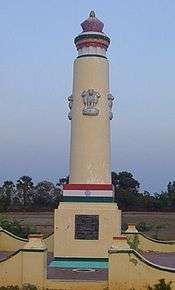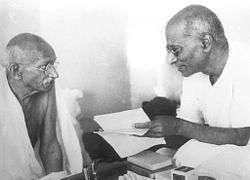Vedaranyam March

The Vedaranyam March or Vedaranyam Satyagraha was organised to protest the salt tax imposed by the British Raj in India. The march took place in April 1930 and was the second of its kind following the Dandi March organised by Mahatma Gandhi,[1][2] both in the framework of the Civil Disobedience Movement.
The march was led by a group of 100 volunteers from the Indian National Congress (INC) under the leadership of C. Rajagopalachari—often referred to as "Rajaji". It began at Trichinopoly (now Tiruchirappalli) and ended in Vedaranyam, a small coastal town in Tanjore District.[3] By collecting salt directly from the sea, the marchers broke the salt law. Rajaji spoke to people along the march's route about the importance of Khādī, issues of 'social disabilities' (cast discrimination) and civil disobedience. The campaign ended on 28 April 1930 when the participants were arrested, following which Rajaji was imprisoned for six months.
Background

In response to a nationwide protest against the British salt tax, Gandhi initiated a salt march on 6 April 1930 to Dandi—then a small village in the Bombay Presidency on the western coast of India. Rajaji, a close associate of Gandhi who also participated in the Dandi march, organised a march to India's east coast to make salt at Vedaranyam, Tanjore District in Madras Presidency.[4] He chose Vedaranyam instead of Tuticorin, a larger salt-making centre, because the former had convenient salt marshes and because Vedaratnam Pillai was a local resident, salt merchant, INC activist and philanthropist who would be able to supply moral and logistic support to the marchers. [5] Rajaji started the march from Trichinopoly, 150 miles (240 km) west of Vedaranyam.[5]
Rajaji was unanimously elected president of the Tamil Nadu Congress Committee ten days prior to the march,[5] and insisted that only people willing to risk death or long prison terms should participate.
March Participants
Nearly 100 members of the INC, including T. S. S. Rajan,[3] Sardar Vedaratnam,[3] Rukmini Lakshmipathi,[6] K. Kamaraj, Aranthangi C.Krishnaswamy, M. Bhaktavatsalam, and C. R. Narasimhan, joined the rally. In addition, social activists such as A. Vaidyanatha Iyer and G. Ramachandran also joined the group.[7]
| March participant | Details |
|---|---|
| C. Rajagopalachari | President of Tamilnadu Pradesh Congress Committee |
| Sardar Vedaratnam | |
| Rukmini Lakshmipathi | |
| K.Venkatesan | |
| T. S. S. Rajan | |
| C.Krishnaswamy Iyer | |
| K. Kamaraj | |
| M. Bhaktavatsalam | |
| C. R. Narasimhan | |
| A. Vaidyanatha Iyer | |
| G. Ramachandran |
The march
The march, coinciding with the Tamil New Year, commenced on 13 April 1930 from T. S. S. Rajan's house in Trichinopoly Cantonment.[3][8] As the march proceeded towards Tanjore district its "astute and energetic" District Collector J. A. Thorne (ICS) tried to stop it. Using newspapers, Tamil handbills and town-criers, Thorne informed would-be hosts that anyone offering food or shelter to the marchers was liable to six-months' imprisonment and a fine.[2] When informed of the threat, Rajaji retorted that he could understand the mindset of his own people better than a British ICS officer could, and added, "Thorne and thistles cannot stem this tide of freedom."[2][9]

Ignoring Thorne's order, Sri Pantulu Iyer, a resident of Kumbakonam,and Sri Krishnaswami Iyer , a resident of aranthangi provided accommodation for two days and arranged a grand dinner for the group at his house before being arrested.[10] Iyer's arrest inspired people to invent ways to help the marchers without getting caught. Food packets were found tied to branches of roadside trees, and when the group rested by the Cauvery riverbank, they found indicators where huge food containers were buried. By contrast, the British police suffered from starvation when local residents refused them food or even water. Indian staff who were employed by the British stopped carrying out their day-to-day activities, while barbers and washermen refused service to government employees.[2]
Despite various obstacles, the group reached Vedaranyam on 28 April, 15 days after setting out.[10] When Gandhi was informed he wrote back: "It is good that our hands and feet are tied so that we can sing with joy. God is the help of the helpless." The speeches made by Rajaji during the march highlighted the importance of Khadi—issues of 'social disabilities' (caste discrimination)—and the significance of the Civil Disobedience Movement.[2] The police, in spite of previous failures, heightened security at Vedaranyam to prevent the marchers from making illegal salt. As soon as they reached Vedaranyam, Rajaji declared that the salt laws would be broken on 30 April 1930 and called for more participants. Aranthangi C.Krishnaswami iyer got bail after 2 days trial. He immediately came to join the march and gave support of Rajaji[11] Sardar Vedaratnam offered accommodation to the group by constructing a camp on the shore. On the same day, when Rajaji and 16 others moved to a place called Edanthevar salt swamp 2 miles (3.2 km) from the camp, a police force led by the District Superintendent arrived there.[11]
The group was asked to surrender. When they refused, Rajaji was arrested and produced before the district magistrate Ponnusamy Pillai.[11] He was sentenced to six-months' imprisonment and was immediately sent to Trichinopoly.[11][12] Other participants were also arrested and tortured by the policemen.[2] Rukmini Lakshmipathy was imprisoned for one year; she was the first woman to serve a jail term for participating in the Salt Satyagraha movement.[6]
Aftermath
The following day, shops all over the state closed. People continued to make salt at Vedaranyam, despite repeated arrests and the use of brutal force by police. Apart from the marchers, 375 people in the Tanjore district were arrested for protests against the British.[13] Collector Thorne, who at first had been confident of his ability to prevent the march, was forced to report to his superiors, "If there ever existed a fervid sense of devotion to the (British) Government, it is now the defunct".[2]
At midnight on 5 May 1930, Gandhi was arrested at his ashram in Karadi and sent to Poona, Bombay State. On 21 May, Sarojini Naidu and Gandhi's son Manilal Gandhi broke into the "Dharasana salt works" together with 2,500 volunteers. They were attacked and arrested by police, resulting in the death of two people and some 320 injured.[13] A fortnight later, Rajaji was transferred From the Trichinopoly prison to Madras, then to the Bellary Central Jail.[14]
Notes
- ↑ Grover 1992, p. 603–.
- 1 2 3 4 5 6 7 "An epic march". The Hindu. 22 April 2001. Retrieved 7 October 2013.
- 1 2 3 4 "Re-enactment brings back Vedaranyam memories". The Hindu. 26 April 2013. Retrieved 7 October 2013.
- ↑ Gandhi 1997, p. 118.
- 1 2 3 Gandhi 1997, p. 119.
- 1 2 Roy 1999, p. 30.
- ↑ "Special postage stamp on freedom fighters and social reformers". Press Information Bureau, Government of India. Retrieved 7 October 2013.
- ↑ "The Vedaranyam March" (PDF). Vedaranyam Municipality. Retrieved 7 October 2013.
- ↑ Gandhi 1997, p. 120.
- 1 2 Gandhi 1997, p. 121.
- 1 2 3 4 Gandhi 1997, p. 122.
- ↑ Sezhiyan, Era (24 August 2011). "The government against satyagrahas, then and now". The Hindu. Retrieved 25 December 2013.
- 1 2 Gandhi 1997, p. 123.
- ↑ Gandhi 1997, p. 124.
References
- Grover, Verinder (1992). Political Thinkers of Modern India: C. Rajagopalachari. Deep & Deep Publications. ISBN 978-81-7100-430-0.
- Roy, Kalpana (1999). Encyclopaedia of violence against women and dowry death in India,. 1. Anmol Publications. ISBN 978-81-261-0343-0.
- Gandhi, Rajmohan (1997). Rajaji: A Life. Penguin Books India. ISBN 978-0-14-026967-3.